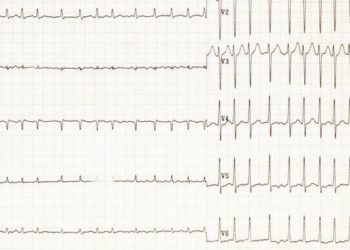Catheter-guided aortic valve replacement and angioplasty has favorable outcomes compared to surgical intervention
1. The composite of all-cause mortality, myocardial infarction, and stroke favoured FFR-guided PCI plus TAVI compared to SAVR plus CABG.
2. All-cause mortality and life-threatening bleeding were lower in FFR-guided PCI plus TAVI.
Evidence Rating Level: 1 (Excellent)
Study Rundown: Many patients with severe aortic stenosis undergo surgical aortic valve replacement (SAVR) combined with coronary artery bypass grafting (CABG). An alternative, less-invasive approach involves transcatheter aortic valve implantation (TAVI) with fractional flow reserve (FFR)-guided percutaneous coronary intervention (PCI). However, the effectiveness of this intervention compared to traditional surgical intervention is unclear. This randomized controlled trial aimed to test the non-inferiority of FFR-guided PCI plus TAVI compared to SAVR plus CABG in patients with severe aortic stenosis and complex coronary artery disease (CCAD). The primary outcome of this study was a composite of mortality, myocardial infarction, and disabling stroke at one year, while a key secondary outcome was all-cause mortality. According to study results, FFR-guided PCI plus TAVI was non-inferior to SAVR plus CABG in terms of mortality and bleeding risk. Although this study was well done, it was limited by a small sample size and single region focus, which may affect the generalizability of findings.
Click to read the study in The Lancet
Relevant Reading: Transcatheter or Surgical Treatment of Aortic-Valve Stenosis
In-depth [randomized controlled trial]: Between May 31, 2018, and Jun 30, 2023, 172 patients were screened for eligibility across 18 tertiary centers in Europe. Included were patients ≥ 70 years old with severe aortic stenosis and complex coronary artery disease eligible for either percutaneous or surgical treatment. Altogether, 172 patients (91 in FFR-guided PCI plus TAVI and 81 in SAVR plus CABG) were included in the final analysis. The primary outcome of a composite endpoint, including mortality, myocardial infarction, and disabling stroke, at one year, favored FFR-guided PCI plus TAVI (4% vs. 23%, pnon-inferiority<0.001). The secondary outcome of all-cause mortality and life-threatening bleeding was significantly lower in the FFR-guided PCI plus TAVI group compared to the SAVR plus CABG group (0% vs. 10% and 2% vs. 12%, hazard ratio [HR] 0.17, psuperiority<0.001), respectively. Findings from this study suggest that FFR-guided PCI plus TAVI is a safe and effective alternative to SAVR plus CABG.
Image: PD
©2025 2 Minute Medicine, Inc. All rights reserved. No works may be reproduced without expressed written consent from 2 Minute Medicine, Inc. Inquire about licensing here. No article should be construed as medical advice and is not intended as such by the authors or by 2 Minute Medicine, Inc.






